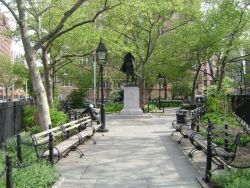Abingdon Square
Abingdon Square Park
What was here before?
In 1744, Sir Peter Warren, a vice admiral in the British Navy, purchased a three hundred-acre farm in the area then known as Greenwich (a corruption of the Dutch for Green District). At that time, Greenwich extended along the Hudson River from what is now Christopher Street north to West 21st Street and was bounded on the east by Minetta Brook and Bowery Lane (now Broadway). Warren and his wife, Susannah De Lancey, lived in a manor house in the area now bordered by West 4th, Bleecker, Charles, and Perry Streets.
The Goodrich Plan of Manhattan in 1827 depicts Abingdon Square as a vacant trapezoidal parcel between Eighth Avenue and Hudson, Bank and Troy (later West 12th) Streets.
How did this site become a park?
Abingdon Square is one of the oldest squares in the city, dating to 1831, when the Common Council decreed that it be enclosed as a public park. The City acquired the parcel that year and enclosed it with a cast iron fence in 1836.
Following the Small Parks Act of 1887, Mayor Abram Hewitt promoted a citywide effort to improve public access to green spaces, leading to a redesign of the square by leading landscape architects Samuel Parsons and Calvert Vaux that included a lawn panel surrounded by a winding path system. Parsons thought at the time “shrubs and flowers would not thrive in [the] shade” of the well-established perimeter trees.
By World War I, due to the park’s intense use, many of the horticultural improvements were eliminated in favor of low-maintenance macadam, later replaced by asphalt in much of the park. In 1921 twenty thousand spectators witnessed Governor Alfred E. Smith present the Abingdon Square Memorial (also known as the Abingdon Doughboy) in memory of local men who fought in World War I. The sculpture faced north towards the headquarters of the sponsor, the Jefferson Democratic Club. The memorial flagstaff was dedicated by the Private Michael J. Lynch Post No. 831 of the Veterans of Foreign Wars in 1933. A small, fenced children’s play area with swings was inserted in the 1930s.
In 1993, the Parks Department’s Monuments Crew conserved the historic doughboy sculpture and in 2004 the park was rebuilt. Exterior sidewalk benches were removed permitting curbside use for a vibrant community Greenmarket. The new park design, inspired by the 1890s Parsons and Vaux plan, reclaimed the park’s corner entryways encouraging access and greened the space with a central oval lawn panel, flower beds, and lavish border plantings. The statue was rotated and relocated to the south entryway. Decorative iron light-poles, entrance urns, and trash receptacles evoke Victorian New York and winding paths are clad with bluestone paving. Today the Abingdon Square Conservancy supports seasonal floral displays and park upkeep of this intimate and welcoming oasis.
Who is this park named for?
Peter Warren and Susan Delancey’s eldest daughter, Charlotte, married Willoughby Bertie, the Fourth Earl of Abingdon. Charlotte’s dowry included the land that came to be known as Abingdon Square. The name is one of the few municipal public places of British association that survived the Revolutionary War.
Check out your park's Vital Signs
Clean & Safe
Green & Resilient
Empowered & Engaged Users
Share your feedback or learn more about how this park is part of a
Vital Park System





